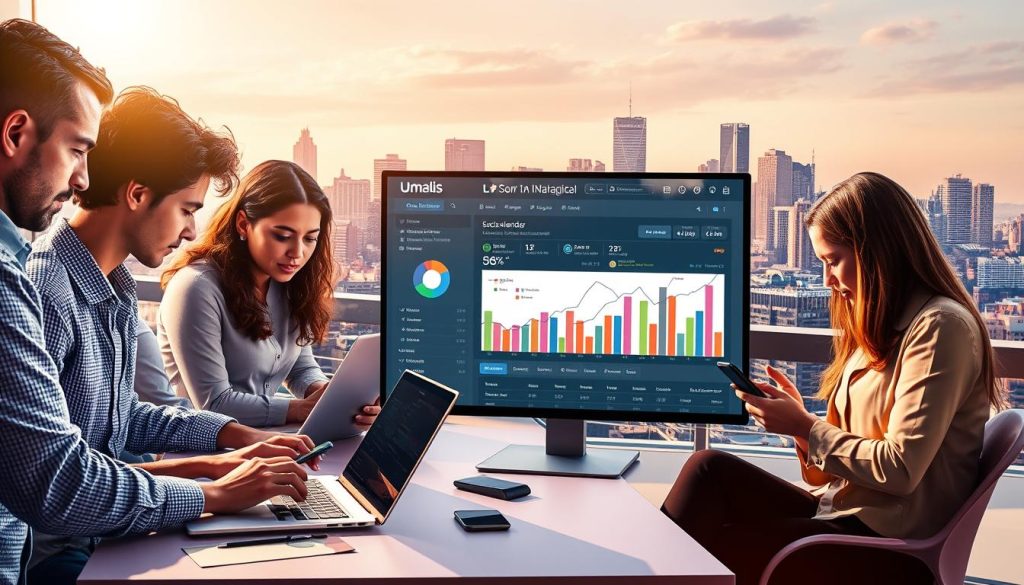Remember the last time you searched for a service provider? Chances are, you clicked the first trustworthy result without scrolling further. Now imagine being that result for potential clients – the professional who stands out in a crowded digital space. Your journey to becoming discoverable starts here.
Building a digital footprint isn’t just about having a website – it’s about creating strategic pathways to your expertise. Like Sarah, a freelance graphic designer who tripled her client base by optimizing her digital presence. Her story isn’t unique, but her approach was intentional.
Visibility determines survival in today’s professional landscape. It’s the difference between hidden talent and recognized authority. While 47% of users abandon sites that load slowly, a well-structured digital presence keeps audiences engaged and search engines interested.
We’ve helped hundreds of independent professionals transform their approach. The secret? Combining technical know-how with human-centric strategies. You’ll learn to balance platform optimization with authentic brand storytelling – because algorithms favor relevance, but clients crave connection.
Table of Contents
Key Takeaways
- Digital prominence directly impacts client acquisition and professional credibility
- Strategic content placement outperforms random online activity
- Website optimization forms the foundation of discoverability
- Consistent branding across platforms builds recognition
- Analytics-driven adjustments maximize visibility efforts
- Security measures protect your growing digital assets
Understanding the Concept of Online Visibility
Imagine a lighthouse guiding ships through foggy waters – that’s what strategic digital positioning does for your brand. Your professional discoverability determines whether clients navigate toward your expertise or drift past to competitors.
What Digital Discoverability Means
Digital prominence isn’t about random internet activity. It’s creating intentional pathways where your target audience naturally seeks solutions. When someone searches for « graphic design services » or « financial consulting, » your offerings should appear as the beacon they need.
Consider how major athletic brands dominate search results for running shoes. Their consistent presence across platforms builds instant recognition. « Your digital footprint should answer questions before clients finish asking them, » notes a leading marketing strategist.
Discoverability’s Role in Professional Growth
Effective positioning impacts three key areas:
- Credibility: 68% of consumers research businesses online before engaging
- Reach: Strategic content placement increases engagement by 3x
- Conversion: Optimized profiles convert 50% more visitors than basic listings
Your digital presence acts as a 24/7 storefront. When properly optimized, it attracts qualified leads while establishing your authority. This isn’t about vanity metrics – it’s creating tangible pathways between client needs and your expertise.
How to Measure Your Online Visibility

Think of your digital presence like a health check-up – you need the right diagnostics to understand what’s working. Professionals use specific metrics to track their performance, just as Nike outperformed Adidas with 35% more mentions last month.
Key Metrics and Tools for Analysis
Start by monitoring website traffic through Google Analytics. This reveals visitor demographics and popular content. Search engine rankings show where you appear for crucial keywords – top positions mean better discovery.
Social media reach tracks engagement across platforms. Tools like Brand24 measure mentions, while Ahrefs analyzes backlinks. Combine these insights with your Presence Score (0-100 scale) for a complete picture. An 83/100 score helped Nike maintain market leadership through measurable strategies.
Competitor Benchmarking and Presence Score
Compare your metrics against industry leaders. Analyze how top performers structure their websites or which keywords they target. Study their social media patterns and content update frequency.
Your Presence Score acts like a progress report. It considers website authority, search visibility, and brand mentions. Regular benchmarking helps identify gaps while celebrating wins. « Data-driven adjustments create sustainable growth, » notes a digital strategist we consulted.
Strategies to Enhance Online Visibility
Just as a map guides travelers, your content directs clients to your expertise. Strategic website optimization turns casual visitors into engaged prospects. It starts with understanding what your audience seeks and how search engines evaluate value.
Precision Content Engineering
Effective optimization begins with keyword research. Identify terms your target clients use when solving problems you address. Tools like Google Keyword Planner reveal search volumes and competition levels. For example, « freelance tax consultant » might attract better-qualified leads than generic « accounting help. »
Incorporate these keywords naturally across your site. Place primary terms in titles, headers, and opening paragraphs. Secondary keywords work well in subheadings and image descriptions. « Content should educate first, optimize second, » advises an SEO specialist we collaborate with.
Technical elements make your site search-friendly. Use clean URLs like yoursite.com/service-area instead of random numbers. Implement advanced SEO techniques through meta tags and structured data. Regular audits fix broken links and improve loading speeds.
Blogging expands your digital footprint. Each post targets niche queries while showcasing expertise. A financial planner might explain « retirement savings myths » to attract pre-retirees. Mix formats – how-to guides, case studies, and video tutorials keep audiences engaged.
Quality trumps quantity. Deep-dive articles with original research outperform generic posts. Partner with industry sites for backlink opportunities. When reputable platforms reference your content, search engines view your site as authoritative.
Monitor performance through analytics. Track which pages convert visitors and which need refinement. Adjust your strategy based on real user behavior rather than assumptions. This approach ensures steady growth in relevant traffic.
Engaging Social Media and Media Posts

Picture a bustling town square where meaningful conversations spark connections – that’s the power of strategic social engagement. Professionals thrive when they balance polished branding with authentic interactions. Quality conversations outperform follower counts every time.
Crafting Consistent and Compelling Posts
Focus on creating value-driven social media posts that align with your expertise. Ask questions like « Which productivity tool saves you 3+ hours weekly? » to spark dialogue. Use video tutorials to demonstrate skills – 85% of users prefer video content for learning new concepts.
Structure your calendar around three pillars:
- Educational content (industry insights)
- Engagement triggers (polls, questions)
- Brand storytelling (client success examples)
Leveraging Social Media Platforms Effectively
Each platform serves distinct purposes. Twitter excels for quick updates and industry news, while LinkedIn drives B2B connections. Follow our proven social media techniques to adapt your approach:
| Platform | Optimal Hashtags | Content Types |
|---|---|---|
| Twitter/X | 2-3 | Text threads, polls, news |
| 10-15 | Carousels, Reels, Stories | |
| 5-8 | Articles, case studies |
Post when your target audience is active – tools like Hootsuite analyze peak engagement times. Respond to comments within 24 hours to maintain momentum. « Social success comes from consistency, not viral luck, » notes a digital strategist we partner with.
Improving SEO for Increased Online Visibility
Effective SEO acts like a bridge connecting your expertise to those actively searching for solutions. By focusing on strategic keyword placement and technical refinements, professionals create structured pathways for both clients and search engines to discover their value.
Mastering Search-Friendly Content
Start with keyword research that mirrors your audience’s needs. Tools like Surfer SEO analyze top-performing pages, helping you craft content that answers real questions. Integrate terms naturally into headers, image descriptions, and meta tags without forcing repetition.
Optimize page speed and mobile responsiveness – factors that impact rankings and user trust. SEMrush excels at identifying technical gaps, from broken links to crawl errors. Pair these insights with freelance SEO strategies to boost your career through measurable improvements.
Regularly update blog posts with fresh data and internal links. This signals relevance to algorithms while guiding visitors to key service pages. Track progress through search console data, adjusting tactics based on what drives qualified traffic.
When done right, SEO becomes a self-sustaining growth tool. It positions your website as the solution clients seek – and the resource search engines prioritize.
FAQ
Why is online visibility crucial for my business?
A strong digital presence ensures your brand reaches potential customers actively searching for your services. It builds trust, drives targeted traffic, and positions you as an industry leader, directly impacting growth and client retention.
What metrics help measure my online presence?
Track website traffic (Google Analytics), keyword rankings (SEMrush), social engagement rates (Hootsuite), and backlink quality (Ahrefs). These reveal how easily audiences find you and where to improve.
How can I optimize my website for search engines?
Focus on keyword research to align content with user intent, improve page load speed, and ensure mobile responsiveness. Use meta tags, headers, and internal linking to help search engines understand your site’s structure.
What role does social media play in boosting visibility?
Platforms like LinkedIn and Instagram let you engage directly with your audience. Consistent, valuable posts increase brand awareness and drive traffic to your site, while shares and tags expand your reach organically.
How do I balance quality and quantity in content creation?
Prioritize depth over frequency. For example, one well-researched blog post per week outperforms daily low-effort updates. Use tools like Grammarly or Hemingway to maintain clarity without sacrificing consistency.
Which SEO techniques are most effective for professionals?
Local SEO (Google My Business profiles), long-tail keywords, and securing backlinks from reputable industry sites. Regularly update existing content to keep it relevant and authoritative.
How often should I update my social media content?
Post 3–5 times weekly on platforms where your audience is active. Tailor formats—LinkedIn articles for thought leadership, Instagram Reels for quick tips—to match platform strengths and user behavior.
What tools track improvements in search rankings?
Use Google Search Console for organic performance insights, Moz Pro for keyword tracking, and Screaming Frog for technical SEO audits. These identify gaps and opportunities to refine your strategy.





